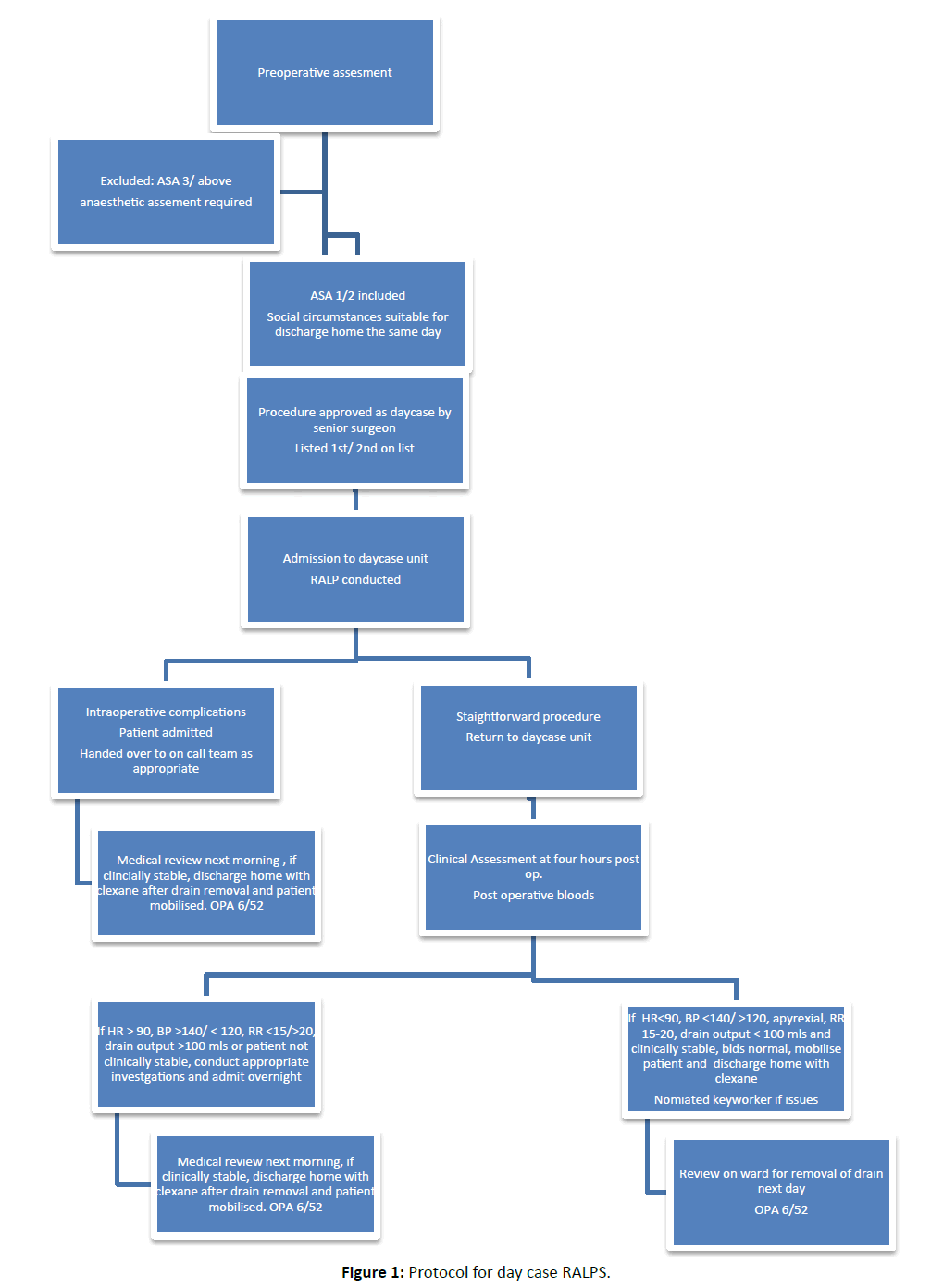Goonewardene SS1*, Gillatt D2 and Persad R3
1The Royal Free and UCL, London, England.
2McQuarrie University, Sydney, Australia.
3North Bristol NHS Trust, Bristol, England.
- *Corresponding Author:
- Goonewardene SS
The Royal Free and UCL
London, England
E-mail: ssg7727@yahoo.co.uk
Submitted Date: July 18, 2016; Accepted Date: July 20, 2016; Published Date: July 27, 2016
Prostate cancer is one of the most common cancers in men. Radical robotic assisted laparoscopic prostatectomy (RALP) is the standard technique to treat localised prostate cancer. Standard operating procedure dictates an overnight admission. Yet the technique is minimally invasive and patients operated on early in the list with no complications are fit for discharge by that evening. We review the literature on Daycase prostatectomies. The majority of patients have no complications and complications that do occur are minor. Based on these results, a new follow-up protocol is developed for Daycase radical robotic laparoscopic prostatectomy.
Keywords
Prostate cancer; Radical robotic assisted
laparoscopic prostatectomy; Day case surgery
Robotic radical prostatectomy has a far lower complication
rate when compared to laparoscopic or retro pubic
prostatectomies [1-3]. Current clinical practice dictates patients
are kept in hospital overnight. This is despite being first/second
on the theatre list and being clinically stable at the end of the
post-operative day. Post-operative clinical practice is often
outlined by potential complications that can occur post-surgery.
Several studies examine the complication rate of RALPs [4-9]. These vary from 0.9% to 26.1%, depending on surgeon
experience and number of cases. Complications range from
minor UTIs/ retention to more major anastomotic leakage,
bladder neck stenosis, when classified according to the Clavien
system [10,11].
In line with current clinical practice, patients are currently
kept in hospital overnight, before being discharged home. In
the hands of an experienced surgeon, RALPS can be performed
routinely with a short operative time, low risk of blood loss and
complications.
The first objective of any RALP is oncological control;
the second is to give patients a straightforward postoperative
recovery with no complications. The complications in one study
were Clavien [12]. Out of 100 patients, only 12 had complications,
with 7 of those being detected 4 hours postop [12]. However,
only five cases needed secondary care intervention, the others
could have been managed by primary care [12]. These results
demonstrate it is possible for this procedure to be conducted as
a day case procedure.
The protocol involved would be as follows. Patients would
undergo pre-assessment. If they are ASA 1 or 2 they are suitable
candidates. If they require an anaesthetic assessment or are ASA 3
and above, they would not be considered for day case surgery. The
clinical notes would be vetted by the senior surgeon and deemed as
suitable for day case. Patients would be admitted as per usual to the
day case unit. The procedure would be conducted. If intraoperative
complications occurred, the patient would be admitted. If the procedure was uneventful, patients would be transferred back
to the day case unit for recovery. Hourly observations would be
taken including drain output for four hours. A post-operative set of
bloods would also be taken. A medical review would be conducted
at four hours post op by the senior surgeon. Provided observations
(HR<90 bpm BP>110/<140, apyrexial, RR 15-20) are within
normal range and bloods are normal, patients can be discharged
home with the drain, and attend the urology ward the next morning
to have it removed. Should patients have any issues post discharge
with complications, they will have a nominated keyworker to get
in contact with re: assessment or admission if required. Patients
with an ASA of 3 or greater would not be candidates for day case
surgery.
Figure 1: Protocol for day case RALPS
References
- Jemal A, Bray F, Center MM, et al. Global cancer statistics. CA Cancer J Clin. 2011; 61:69-90.
- Kowalczyk KJ, Levy JM, Caplan CF, et al. Temporal national trends of minimally invasive and retropubic radical prostatectomy outcomes from 2003 to 2007: results from the 100% Medicare sample. EurUrol 2012; 61:803ÃÆÃâÃââÃÆââ¬Å¡Ã¢ââ¬Å¡Ã¬ÃÆââ¬Å¡Ã¢ââ¬Ã
â9.
- Trinh Q-D, Sammon J, Sun M, et al. Perioperative outcomes of robot assisted radical -prostatectomy compared with open radical prostatectomy: results from the Nationwide Inpatient Sample. EurUrol 2012;61:679ÃÆÃâÃââÃÆââ¬Å¡Ã¢ââ¬Å¡Ã¬ÃÆââ¬Å¡Ã¢ââ¬Ã
â85
- Fischer B, Engel N, Fehr JL, et al. Complications of robotic assisted radical prostatectomy. World J Urol. 2008; 26:595-602.
- Tewari A, Srivasatava A, Menon M, et al. A prospective comparison of radical retropubic and robot-assisted prostatectomy: experience- in one institution. BJU Int. 2003; 92:205-210.
- Berryhill R Jr, Jhaveri J, Yadav R, et al. Robotic prostatectomy: a review of outcomes compared with laparoscopic and open approaches. Urology. 2008; 72:15-23.
- Patel VR, Tully AS, Holmes R, et al. Robotic radical prostatectomy in the community setting-the learning curve and beyond: initial 200 cases. J Urol. 2005; 174:269-272.
- Hu JC, Nelson RA, Wilson TG, et al. Perioperative complications of laparoscopic and robotic assisted laparoscopic radical prostatectomy. J Urol. 2006; 175:541-546.
- Bhandari A, McIntire L, Kaul SA, et al. Perioperative complications of robotic radical prostatectomy.
- Clavien A, Sanabria JR, Strasberg SM. Proposed classification of complications of surgery with examples of utility in cholecystectomy. Surgery. 1992; 111:518-526.
- Dindo D, Demartines N, Clavien PA. Classification of surgical complications: a new proposal with evaluation in a cohort of 6336 patients and results of a survey. Surg. 2004; 240:205-213.
- Goonewardene S.S & Rowe E.W 2014. Robotic radical prostatectomy: a day case procedure. Journal of Laparoscopy and Advanced Surgical Techniques: Mary Ann Liebert Inc.


